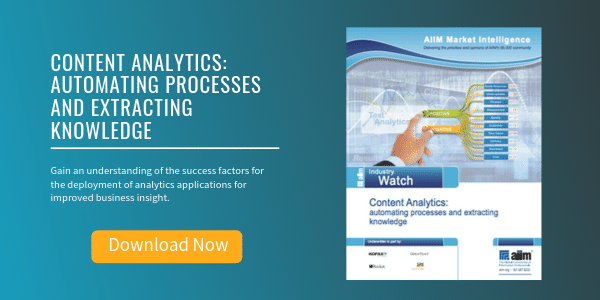
Five Keys to Leading in the Age of Analytics
Data and analytics have redefined the way we compete. Data is a critical corporate asset that organizations are starting to monetize in new ways to get ahead of their competition. The bottom line? Companies that leverage data to drive the performance of their organization’s decisions are winning at a faster rate than their competition.
The size of the organization is no longer a competitive barrier to producing world-class analytics. A general trend emerging in the marketplace is that the competitive advantage that large companies have in the use of analytics is disappearing as the cost of accessing, processing, and storing data is plummeting. Large teams of data scientists and millions of dollars are no longer required to drive insights from a company’s data assets. Analytical methods and tools are becoming more ubiquitous and less costly, leveling the playing fields for companies large and small.
Executives that know how to lead in this new era of data analytics will outpace their competition. It will require a shift in how you view analytics and the importance the organization places on the building of analytical capabilities. There are five keys to leading in the age of analytics:
1. Analytics as a Corporate Strategy
Embed analytical capabilities and strategies into your corporate objectives. Having a clear vision of winning through analytics is essential to provide direction and organizational energy for the development of these needed capabilities. It is through these new methods, tools, and techniques that you will develop new products, services, markets, and opportunities.
2. Monetization Strategy
Develop monetization strategies as valuable corporate assets. A Monetization Strategy is a plan to achieve one or more business goals through tactics or actions that improve the bottom line, either increasing revenue or reducing costs. In the same way, an organization might develop KPI’s to help manage and understand business performance, monetization strategies that drive a competitive advantage should be developed continuously and shared throughout the organization.
3. Develop Scalable Insights and Capabilities
Building one-off analytical solutions have been the norm in corporate America. Hours are poured into solving difficult problems to capture a revenue opportunity, only to have the analytics, once developed to support the plan, lie dormant, or never utilized again. Leaders should look to develop monetization strategies and analytics that are automated, repeatable, and scalable throughout their organization. This approach will lead to analytics that are scaled throughout the organization that other departments can leverage rather than building their own siloed solutions.
4. Big Data is More Than Just Big Hype
If your organization has not started on the path toward building out a big data environment, you are behind the curve. Big data is here to stay and providing several benefits and new capabilities.
One of the primary drivers behind the first wave of implementations is to lower the cost structure of storing the ocean of data that organizations are swimming in. Traditional data platforms are costly and do not provide an economical solution for storing massive amounts of information. By leveraging low-cost commodity hardware, companies can store petabytes of information at a very reasonable cost.
Once organizations have brought together a large number of disparate datasets, they are able to drive new insights that were previously too difficult or expensive to produce. This includes a lower level of granular data, social media information, search data, images, and keeping a richer history of information. An example of this type of analysis is the use of big data by car dealerships who are utilizing search data to determine the right stocking levels of various products based on customer search patterns. If consumers within a certain radius are searching more on trucks, they are able to optimize inventory levels better to match anticipated consumer demand.
5. Artificial Intelligence (AI)
As leaders, understanding the current capabilities of AI, what it can bring to bear for your organization, and where to start your journey are going to be key questions to wrap your head around. There is a lot of hype around AI and how fast it will automate jobs. The truth is that we are a long way off from the masses losing their jobs to AI, but there are several ways you can begin to tap into this emerging technology. An important point you should consider is that AI is not new. It has been leveraged on retail company’s websites since the late 90’s helping to make recommendations on purchases, cross-selling products, or solving consumer issues. The question for an analytical leader is how to leverage AI and where to start. Outside of the online retail world, the industry is beginning to use the advances in AI to automate research, especially in the medical field and legal fields. Instead of doctors pouring over hundreds of articles and case files to find out the latest protocols and treatment plans, hospitals are taking advantage of AI to speed up the information collection and assimilation process freeing doctors to spend more time with their patients versus researching. Looking for areas that require standardized, repetitive tasks or areas requiring diagnostic research as a great first place to start.
As a leader, the adoption of analytics is a necessity to help your organization stay competitive. Having a clear vision, concrete objectives, and identifying the analytical competency to develop in your organization will help your company win in the market place.
About Andrew Wells
Andrew is the CEO of Aspirent, a management consulting firm focused on analytics, and author of the book Monetizing Your Data: a guide to turning data into profit driving strategies and solutions. He has extensive experience building Analytical Solutions for a wide range of companies, from Fortune 500s to small non-profits. Andrew focuses on helping organizations utilize their data to make impactful decisions that drive revenue through monetization strategies. He has been building analytical solutions for over 25 years and is excited to share these practical methods, tools, and techniques with a wider audience.



